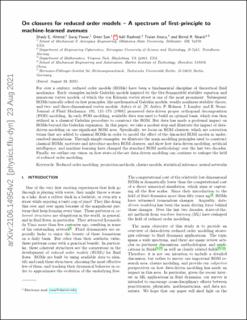| dc.description.abstract | For over a century, reduced order models (ROMs) have been a fundamental discipline of theoretical fluid mechanics. Early examples include Galerkin models inspired by the Orr–Sommerfeld stability equation and numerous vortex models, of which the von Kármán vortex street is one of the most prominent. Subsequent ROMs typically relied on first principles, like mathematical Galerkin models, weakly nonlinear stability theory, and two- and three-dimensional vortex models. Aubry et al. [J. Fluid Mech. 192, 115–173 (1988)] pioneered the data-driven proper orthogonal decomposition (POD) modeling. In early POD modeling, available data were used to build an optimal basis, which was then utilized in a classical Galerkin procedure to construct the ROM, but data have made a profound impact on ROMs beyond the Galerkin expansion. In this paper, we take a modest step and illustrate the impact of data-driven modeling on one significant ROM area. Specifically, we focus on ROM closures, which are correction terms that are added to the classical ROMs in order to model the effect of the discarded ROM modes in under-resolved simulations. Through simple examples, we illustrate the main modeling principles used to construct the classical ROMs, motivate and introduce modern ROM closures, and show how data-driven modeling, artificial intelligence, and machine learning have changed the standard ROM methodology over the last two decades. Finally, we outline our vision on how the state-of-the-art data-driven modeling can continue to reshape the field of reduced order modeling. | en_US |
